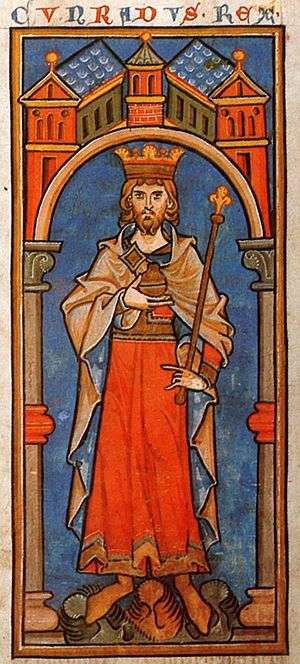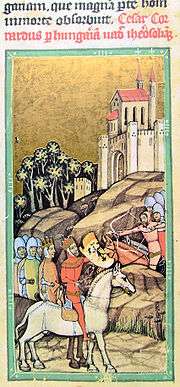Conrad III of Germany
Conrad III (German: Konrad; Italian: Corrado; 1093 or 1094 – 15 February 1152) of the Hohenstaufen dynasty was from 1116 to 1120 Duke of Franconia, from 1127 to 1135 anti-king of his predecessor King Lothair III and from 1138 until his death in 1152 King in the Holy Roman Empire. He was the son of Duke Frederick I of Swabia and Agnes,[1] a daughter of the Salian Emperor Henry IV.[2][3]
| Conrad III | |
|---|---|
 King Conrad III (Cunradus rex) in a miniature from the Chronica sancti Pantaleonis, c. 1240 | |
| King of Germany (formally King of the Romans) | |
| Reign | 7 March 1138 – 15 February 1152 |
| Coronation | 13 March 1138, Aachen |
| Predecessor | Lothair III |
| Successor | Frederick I |
| King of Italy | |
| Reign | 1128–1135 |
| Coronation | 29 June 1128, Milan |
| Predecessor | Henry V |
| Successor | Frederick I |
| Born | 1093 or 1094 |
| Died | 15 February 1152 Bamberg, Bavaria |
| Burial | |
| Spouse | |
| Issue | |
| House | Hohenstaufen |
| Father | Frederick I, Duke of Swabia |
| Mother | Agnes |
| Religion | Roman Catholicism |
Descent
The origin of the House of Hohenstaufen in the Duchy of Swabia has not been conclusively established. As the name came from the Hohenstaufen Castle (built in 1105) Conrad's great-grandfather Frederick of Staufen was count in the Riesgau and in 1053 became Swabian Count palatine. His son Frederick of Buren probably resided near present-day Wäschenbeuren and about 1050 married Countess Hildegard of Egisheim-Dagsburg from Alsace.[2]
Conrad's father took advantage of the conflict between King Henry IV of Germany and the Swabian duke Rudolf of Rheinfelden during the Investiture Controversy. When Rudolf had himself elected German anti-king at Forchheim in 1077, Frederick of Hohenstaufen remained loyal to the royal crown and in 1079 was vested with the Duchy of Swabia by Henry IV, including an engagement with the king's minor daughter Agnes. He died in 1105, leaving two sons, Conrad and his elder brother Frederick II, who inherited the Swabian ducal title. Their mother entered into a second marriage with Babenberg margrave Leopold III of Austria.[4][5]
Biography
In 1105 Henry IV, Holy Roman Emperor since 1084, was overthrown by his son Henry V, Conrad's uncle. Emperor since 1111, Henry V preparing for his second campaign to Italy upon the death of Margravine Matilda of Tuscany, in 1116 appointed Conrad a Duke of Franconia.[6] Conrad was marked out to act as regent for Germany, together with his elder brother, Duke Frederick II of Swabia. At the death of Henry V in 1125, Conrad unsuccessfully supported Frederick II for the kingship of Germany. Frederick was placed under a ban and Conrad was deprived of Franconia and the Kingdom of Burgundy, of which he was rector. With the support of the imperial cities, Swabia, and the Duchy of Austria, Conrad was elected anti-king at Nuremberg in December 1127.[7]
Conrad quickly crossed the Alps to be crowned King of Italy by Anselmo della Pusterla, Archbishop of Milan, in the village of Monza.[8] Over the next two years, he failed to achieve anything in Italy, however, and returned to Germany in 1130, after Nuremberg and Speyer, two strong cities that supported him, fell to Lothair in 1129. Conrad continued in Lothair's opposition, but he and Frederick were forced to acknowledge Lothair as emperor in 1135, during which time Conrad relinquished his title as King of Italy. After this they were pardoned and could take again possession of their lands.[9]

After Lothair's death (December 1137), Conrad was elected king at Coblenz on 7 March 1138, in the presence of the papal legate Theodwin. Conrad was crowned at Aachen six days later (13 March) and was acknowledged in Bamberg by several princes of southern Germany.[10] As Henry the Proud, son-in-law and heir of Lothair and the most powerful prince in Germany, who had been passed over in the election, refused to do the same, Conrad deprived him of all his territories, giving the Duchy of Saxony to Albert the Bear and that of Bavaria to Leopold IV, Margrave of Austria. Henry, however, retained the loyalty of his subjects. The civil war that broke out is considered the first act of the struggle between Guelphs and Ghibellines, which later extended southwards to Italy. After Henry's death (October 1139), the war was continued by his son Henry the Lion, supported by the Saxons, and by his brother Welf VI. Conrad, after a long siege, defeated the latter at Weinsberg in December 1140, and in May 1142 a peace agreement was reached in Frankfurt.[9]
In the same year, Conrad entered Bohemia to reinstate his brother-in-law Vladislav II as prince. The attempt to do the same with another brother-in-law, the Polish prince Ladislaus the Exile, failed. Bavaria, Saxony, and the other regions of Germany were in revolt.
In 1146, Conrad heard Bernard of Clairvaux preach the Second Crusade at Speyer, and he agreed to join Louis VII in a great expedition to the Holy Land. At the imperial diet in Frankfurt in March 1147 Conrad and the assembled princes entrusted Bernard of Clairvaux with the recruitment for the Wendish crusade.[11]
Before leaving, he had the nobles elect and crown his son Henry Berengar king. The succession secured in the event of his death, Conrad set out. His army of 20,000 men went overland, via Hungary, causing disruptions in the Byzantine territories through which they passed. They arrived at Constantinople by September 1147, ahead of the French army.[12][13]
Rather than taking the coastal road around Anatolia through Christian-held territory, by which he sent most of his noncombatants, Conrad took his army across Anatolia. On 25 October 1147, they were defeated by the Seljuk Turks at the Battle of Dorylaeum. Conrad and most of the knights escaped, but most of the foot soldiers were killed or captured. The remaining 2,000 men of the German army limped on to Nicaea, where many of the survivors deserted and tried to return home. Conrad and his adherents had to be escorted to Lopadium by the French, where they joined the main French army under Louis. Conrad fell seriously ill at Ephesus and was sent to recuperate in Constantinople, where his host the Emperor Manuel I acted as his personal physician. After recovering, Conrad sailed to Acre, and from there reached Jerusalem. He participated in the ill-fated Siege of Damascus and after that failure, grew disaffected with his allies. Another attempt to attack Ascalon failed when Conrad's allies did not appear as promised, and Conrad returned to Germany.[13]
In 1150, Conrad and Henry Berengar defeated Welf VI and his son Welf VII at the Battle of Flochberg. Henry Berengar died later that year and the succession was thrown open. The Welfs and Hohenstaufen made peace in 1152 and the peaceful succession of one of Conrad's family was secured.
Conrad was never crowned emperor and continued to style himself "King of the Romans" until his death. On his deathbed, in the presence of only two witnesses, his nephew Frederick Barbarossa and the Bishop of Bamberg, he allegedly designated Frederick his successor, rather than his own surviving six-year-old son Frederick. Frederick Barbarossa, who had accompanied his uncle on the unfortunate crusade, forcefully pursued his advantage and was duly elected king in Cologne a few weeks later. The young son of the late king was given the Duchy of Swabia.
Conrad left no male heirs by his first wife, Gertrude von Komburg. In 1136, he married Gertrude of Sulzbach, who was a daughter of Berengar II of Sulzbach, and whose sister Bertha was married to Emperor Manuel. Gertrude was the mother of Conrad's children and the link which cemented his alliance with Byzantium.[14]
Ancestry
| Ancestors of Conrad III of Germany | |||||||||||||||||||||||||||||||||||||||||||||||||||||||||||||||||||||||||||||||||||||||||||||||||||||||||||||||||||||||||||||||||||||||||||||||||||||||||||||||||||||||||||||||||||||||||||||||||||||||||||||||||||||||||||||||||||||||||||||||||||||||||||||||||||||||||||||||||||||||||
|---|---|---|---|---|---|---|---|---|---|---|---|---|---|---|---|---|---|---|---|---|---|---|---|---|---|---|---|---|---|---|---|---|---|---|---|---|---|---|---|---|---|---|---|---|---|---|---|---|---|---|---|---|---|---|---|---|---|---|---|---|---|---|---|---|---|---|---|---|---|---|---|---|---|---|---|---|---|---|---|---|---|---|---|---|---|---|---|---|---|---|---|---|---|---|---|---|---|---|---|---|---|---|---|---|---|---|---|---|---|---|---|---|---|---|---|---|---|---|---|---|---|---|---|---|---|---|---|---|---|---|---|---|---|---|---|---|---|---|---|---|---|---|---|---|---|---|---|---|---|---|---|---|---|---|---|---|---|---|---|---|---|---|---|---|---|---|---|---|---|---|---|---|---|---|---|---|---|---|---|---|---|---|---|---|---|---|---|---|---|---|---|---|---|---|---|---|---|---|---|---|---|---|---|---|---|---|---|---|---|---|---|---|---|---|---|---|---|---|---|---|---|---|---|---|---|---|---|---|---|---|---|---|---|---|---|---|---|---|---|---|---|---|---|---|---|---|---|---|---|---|---|---|---|---|---|---|---|---|---|---|---|---|---|---|---|---|---|---|---|---|---|---|---|---|---|---|---|---|---|---|---|
| |||||||||||||||||||||||||||||||||||||||||||||||||||||||||||||||||||||||||||||||||||||||||||||||||||||||||||||||||||||||||||||||||||||||||||||||||||||||||||||||||||||||||||||||||||||||||||||||||||||||||||||||||||||||||||||||||||||||||||||||||||||||||||||||||||||||||||||||||||||||||
See also
- Kings of Germany family tree
References
- Frederick I 2000, p. xii.
- John Middleton (1 June 2015). World Monarchies and Dynasties. Routledge. pp. 403–. ISBN 978-1-317-45158-7.
- Wilhelm Muschka (22 May 2012). Agnes von Waiblingen - Stammmutter der Staufer und Babenberger-Herzöge: Eine mittelalterliche Biografie. Tectum Wissenschaftsverlag. pp. 74–. ISBN 978-3-8288-5539-7.
- Wolfram Ziegler (2008). König Konrad III. (1138-1152): Hof, Urkunden und Politik. Böhlau Verlag Wien. ISBN 978-3-205-77647-5.
- Thomas Oliver Schindler. "Die Staufer - Ursprung und Aufstieg eines Herrschergeschlechts". Grin. Retrieved 29 February 2020.
- Barber 2004, p. 193.
- Lothar Mikulla (25 April 1997). Fürstenopposition gegen die Reichsgewalt im 12. Jahrhundert. diplom.de. pp. 41–. ISBN 978-3-8324-0032-3.
- Marina 2013, p. 395.
- Knut Görich (2006). Die Staufer: Herrscher und Reich. C.H.Beck. pp. 28–. ISBN 978-3-406-53593-2.
- Daniel Quitz (19 May 2014). Die Königswahl Konrad III. 1138 und seine Politik gegenüber den Welfen. GRIN Verlag. pp. 1–. ISBN 978-3-656-65725-5.
- Andrew Jotischky (21 July 2018). Pope Eugenius III (1145-1153): the First Cistercian Pope. Amsterdam University Press. ISBN 978-90-485-3720-4.
- Jonathan Phillips (8 January 2008). The Second Crusade: Extending the Frontiers of Christendom. Yale University Press. pp. 104–. ISBN 978-0-300-16836-5.
- Asst Prof Susanna A Throop (28 July 2013). Crusading as an Act of Vengeance, 1095–1216. Ashgate Publishing, Ltd. pp. 73–. ISBN 978-1-4094-8211-6.
- Johannes Bühler (2012). Die Hohenstaufen. BoD – Books on Demand. pp. 78–. ISBN 978-3-8460-0849-2.
- John M.Jeep. "Medieval Germany: An Encyclopedia (Routledge Encyclopedias of the Middle Ages)". EPDF. Retrieved 28 February 2020.
- I. S. Robinson (4 December 2003). Henry IV of Germany 1056-1106. Cambridge University Press. pp. 290–. ISBN 978-0-521-54590-7.
- Pennington, Reina (2003). Amazons to Fighter Pilots: An Autobiographical Dictionary of Military Women. Westport, CT: Greenwood Press. p. 3. ISBN 0313327076.
Sources
- Barber, Malcolm (2004). The Two Cities: Medieval Europe 1050–1320. Routledge.CS1 maint: ref=harv (link)
- Frederick I (2000). The Crusade of Frederick Barbarossa: The History of the Expedition of the Emperor Frederick and related texts. Translated by Loud, G.A. Ashgate Publishing.CS1 maint: ref=harv (link)
- Marina, Areli (2013). "The Langobard Revival of Matteo il Magno Visconti, Lord of Milan". I Tatti Studies in the Italian Renaissance. University of Chicago Press. Vol. 16, No. 1/2 September.CS1 maint: ref=harv (link)
- Ziegler, W. König Konrad III. (1138–1152). Hof, Urkunden und Politik (= Forschungen zur Kaiser- und Papstgeschichte des Mittelalters. Band 26) Böhlau, Wien u. a. 2008
- Baldwin, M. W. A History of the Crusades: the first hundred years, 1969.
Conrad III of Germany Born: 1093 Died: 1152 | ||
| Regnal titles | ||
|---|---|---|
| Preceded by Henry V |
King of Italy 1128–1135 |
Succeeded by Frederick I |
| Preceded by Lothair III |
German King (formally King of the Romans) (with Henry Berengar (1147 - 1150) 1138–1152 | |